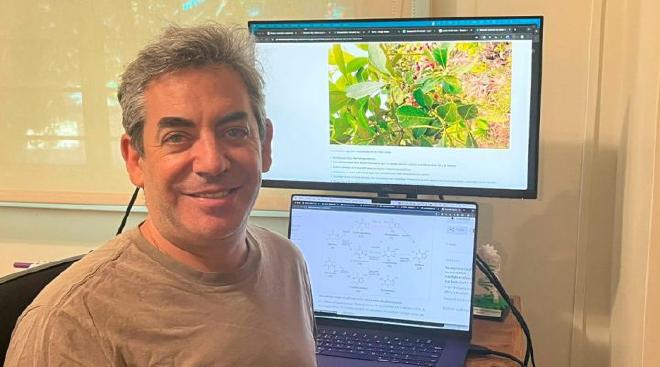Especialistas del CONICET descifraron el genoma de la yerba mate
Table of Contents

Especialistas del CONICET lideraron un proyecto internacional que descifró el genoma de la yerba mate Ilex paraguariensis, un cultivo del cual Argentina es el primer productor y que se comercializa para la elaboración de mate, la tercera infusión con cafeína más consumida en el mundo, y otras aplicaciones. El avance se describe en la revista científica eLife.

“El mapa del genoma de la yerba mate -Ilex paraguariensis- constituye una herramienta que será útil para el mejoramiento genético de esa planta y su aprovechamiento en la industria alimentaria, farmacéutica y biotecnológica”, afirmó Adrián Turjanski, director del trabajo e investigador del CONICET en el Instituto de Química Biológica de la Facultad de Ciencias Exactas y Naturales de la UBA (IQUIBICEN, CONICET-UBA). “También servirá para desarrollar variedades más resistentes a climas y suelos diferentes”, añadió.

El genoma como objetivo #
Federico Vignale, primer autor del estudio, participó del proyecto desde sus inicios como becario doctoral del CONICET bajo la supervisión de Turjanski. “Este proyecto, que marcó un antes y un después en mi carrera científica, tuvo como objetivo secuenciar (‘leer’) el genoma (‘ADN’) de la planta de yerba mate (Ilex paraguariensis) para comprender, entre otras cosas, cómo produce la cafeína, uno de sus componentes más importantes. A pesar de lo que muchos creen, el mate contiene cafeína, no ‘mateína’. De hecho, la molécula de ‘mateína’ no existe”.
¿Mateína o cafeína? #
Cuando los autores del estudio comenzaron el proyecto, ya se había secuenciado el genoma de un gran número de plantas agrícolas como el té (Camellia sinensis) y el café (Coffea canephora y Coffea arabica), pero de la planta de yerba mate no se conocía su ADN y tampoco se sabía cómo producía la cafeína.
“Comprender cómo la planta sintetiza la cafeína resulta interesante desde un punto de vista evolutivo y también comercial”, explicó Vignale quien ahora continúa su carrera científica en una unidad del Laboratorio Europeo de Biología Molecular (EMBL) en Hamburgo, Alemania. “Los altos niveles de cafeína en el mate son responsables del malestar por acidez que algunas personas experimentan al consumirlo. Por lo tanto, en el futuro, al saber cómo la planta sintetiza la cafeína, se podría desarrollar una variedad de yerba mate que no lo produzca para satisfacer aquellos consumidores que así lo prefieran”.

La tesis de doctorado de Maximiliano Rossi, investigador del CONICET en el Instituto de Biotecnología Misiones Dra. María Ebe Reca (InBioMis, FCEQyN-Universidad Nacional de Misiones), forma parte del avance científico publicado en eLife. “Hoy la cafeína es el principal compuesto fitoquímico de importancia económica en el mercado tanto del café, té o mate, pero ahora, con este avance recién publicado, abrimos la jugada a nuevos mercados desde el conocimiento de la genómica para el mejoramiento de la planta con la posibilidad de desarrollar productos descafeinados con plantas que naturalmente no produzcan ese alcaloide y sí produzcan, en mayores cantidades, otros compuestos vegetales de alto beneficio para la salud dadas sus propiedades antioxidantes, antidiabéticas y estimulantes del sistema nervioso”.

Para Pedro Zapata, investigador del CONICET en el InBioMis, también autor del estudio y director de la tesis de doctorado de Rossi, “el avance que realizamos es un gran aporte de la ciencia para el desarrollo agrobiotecnológico futuro del cultivo de la yerba mate -Ilex paraguariensis-, un cultivo de importancia económica para Argentina y también para la Provincia de Misiones en la que trabajo con mi equipo”.
La ruta de la síntesis de la cafeína en la yerba mate #
Para secuenciar el genoma de Ilex paraguariensis se tomaron muestras de ADN de plantas de esa variedad en Misiones y Corrientes, las provincias que concentran la mayoría de las plantaciones de esa variedad y que convierten a Argentina en el primer productor mundial.
Con herramientas bioinformáticas y otras tecnologías, los autores del estudio lograron identificar los genes involucrados en la síntesis de la cafeína en el genoma de la yerba mate -Ilex paraguariensis- mediante un trabajo de colaboración con Todd Barkman, un botánico estadounidense experto en la síntesis de cafeína en plantas que trabaja en la Universidad de Western Michigan, en Estados Unidos.
“Lo más interesante de este hallazgo es que la ruta biosintética de la cafeína en la yerba mate es diferente a la de otras plantas como el té y el café. Esto sugiere que la síntesis de cafeína evolucionó de manera convergente (“independiente”) en estas especies”, detalló Vignale.
Rossi, quien en 2017 realizó una pasantía doctoral en el laboratorio de Barkman, destacó que durante la realización del trabajo también se pudo determinar que un ancestro de la yerba mate duplicó su ADN hace aproximadamente 50 a 70 millones de años. “Esta duplicación genética ancestral pudo haber sido clave en la evolución de la complejidad metabólica de la planta, facilitando la producción de una amplia gama de compuestos naturales, como terpenos, flavonoides, fenoles y xantinas conocidos por otorgarle al mate sus preciadas propiedades antioxidantes, antidiabéticas y estimulantes del sistema nervioso”.
Para Zapata “es destacable la colaboración nacional e internacional en este macro proyecto que permitió llegar a estos resultados tan útiles para una actividad económica muy importante de la Argentina. El camino recién empieza, pero lo importante es que a partir de los resultados que presentamos en nuestro trabajo pueden derivarse múltiples proyectos con potenciales aplicaciones en la industria alimenticia y farmacéutica”.
En esa línea, Turjanski concluyó: “Nos alegra ver cómo un trabajo colaborativo con colegas de Misiones, Corrientes y de otros países logró presentar una herramienta que puede ser útil para diferentes proyectos de interés agronómico y económico centrados en una planta emblemática de la cultura de nuestro país”.
Del trabajo también participaron Raúl Acevedo y Pedro Sansberro, del Instituto de Botánica del Nordeste (IBONE, CONICET- Universidad Nacional del Nordeste); Pedro D. Zapata, del InBioMis; Carlos Modenutti y Ezequiel Sosa, del IQUIBICEN; Dardo Marti, del Instituto de Biología Subtropical (IBS, CONICET-UNaM), con sede en Posadas, Misiones; Lucas Defelipe, del EMBL; Renato R.M. Oliveira, Gisele Nunes y Guilherme Oliveira, del Instituto Tecnológico Vale, en Brasil; Andrea Hernández García y Satish Nair, de la Universidad de Illinois en Estados Unidos; Germán Burguener, de la Universidad de California, Estados Unidos; y Madeline Smith y Nicole Dubs, de la Universidad de Western Michigan*.
Referencia bibliográfica:
Vignale FA, Hernandez Garcia A, Modenutti CP, Sosa EJ, Defelipe LA, Oliveira R, Nunes GL, Acevedo RM, Burguener GF, Rossi SM, Zapata PD, Marti DA, Sansberro P, Oliveira G, Catania EM, Smith MN, Dubs NM, Nair S, Barkman TJ , Turjanski AG. (2024) Yerba mate (Ilex paraguariensis) genome provides new insights into convergent evolution of caffeine biosynthesis. eLife 14:e104759.
https://doi.org/10.7554/eLife.104759
English version #
CONICET specialists deciphered the yerba mate genome #
CONICET specialists led an international project that deciphered the genome of the yerba mate Ilex paraguariensis, a crop of which Argentina is the leading producer and which is marketed for the production of mate, the third most consumed caffeinated infusion in the world, and other applications. The progress is described in the scientific journal eLife.

“The genomic map of the yerba mate Ilex paraguariensis is a tool that will be useful for the genetic improvement of this plant and its use in the food, pharmaceutical and biotechnology industries,” says Adrián Turjanski, director of the work and CONICET researcher at the Institute of Biological Chemistry of the Faculty of Exact and Natural Sciences of the UBA (IQUIBICEN, CONICET-UBA). He added that “it will also serve to develop varieties that are more resistant to different climates and soils.”
Federico Vignale, the first author of the study, participated in the project from the beginning as a CONICET doctoral fellow under Turjanski’s supervision. “This project, which marked a turning point in my scientific career, aimed to sequence (‘read’) the genome (‘DNA’) of the yerba mate plant (Ilex paraguariensis) to understand, among other things, how it produces caffeine, one of its most important components. Despite what many believe, mate contains caffeine, not ‘mateine’. In fact, the ‘mateine’ molecule does not exist.”

When the study’s authors began the project, the genomes of a large number of agricultural plants such as tea (Camellia sinensis) and coffee (Coffea canephora and Coffea arabica) had already been sequenced, but the DNA of the yerba mate plant was unknown, nor was it known how it produced caffeine.
“Understanding how the plant synthesizes caffeine is interesting from an evolutionary and also commercial point of view,” explained Vignale, who now continues his scientific career at a unit of the European Molecular Biology Laboratory (EMBL) in Hamburg, Germany. He added that “the high levels of caffeine in mate are responsible for the acidity discomfort that some people experience when consuming it. Therefore, in the future, by knowing how the plant synthesizes caffeine, a variety of yerba mate could be developed that does not produce caffeine to satisfy those consumers who prefer it.”

The doctoral thesis of Maximiliano Rossi, CONICET researcher at the Misiones Biotechnology Institute Dra. María Ebe Reca (InBioMis, FCEQyN-Universidad Nacional de Misiones), is part of the scientific advance published in eLife. “Today, caffeine is the main phytochemical compound of economic importance in the coffee, tea and mate markets, but now, with this recently published advance, we are opening up the game to new markets based on the knowledge of genomics for plant improvement with the possibility of developing decaffeinated products with plants that do not naturally produce this alkaloid and do produce, in larger quantities, other plant compounds that are highly beneficial to health given their antioxidant, antidiabetic and nervous system stimulating properties.”

For Pedro Zapata, CONICET researcher at InBioMis, also author of the study and director of Rossi’s doctoral thesis, “the progress we made is a great contribution of science for the future agrobiotechnological development of the cultivation of yerba mate Ilex paraguariensis, a crop of economic importance for Argentina and also for the Province of Misiones where I work with my team.”
The route of caffeine synthesis in yerba mate #
To sequence the genome of Ilex paraguariensis, DNA samples were taken from plants of that variety in Misiones and Corrientes, the provinces that concentrate the majority of plantations of that variety and that make the country the world’s leading producer.
**Using bioinformatics tools and other technologies, the authors of the study were able to identify the genes involved in the synthesis of caffeine in the genome of the yerba mate Ilex paraguariensis through collaborative work with Todd Barkman, an American botanist expert in the synthesis of caffeine in plants, who works at Western Michigan University in the United States.
“The most interesting thing about this finding is that the biosynthetic pathway of caffeine in yerba mate is different from that of other plants such as tea and coffee. This suggests that caffeine synthesis evolved convergently (“independently”) in these species,” explained Vignale.
Rossi, who completed a doctoral internship in Barkman’s lab in 2017, notes that during the course of the work, it was also possible to determine that an ancestor of yerba mate duplicated its DNA approximately 50 to 70 million years ago. “This ancestral genetic duplication may have been key in the evolution of the plant’s metabolic complexity, facilitating the production of a wide range of natural compounds, such as terpenes, flavonoids, phenols and xanthines known to give mate its prized antioxidant, antidiabetic and nervous system-stimulating properties.”
For Zapata, “the national and international collaboration in this macro project is remarkable, as it allowed us to achieve these results that are so useful for a very important economic activity in Argentina. The journey has only just begun, but the important thing is that the results we present in our work can lead to multiple projects with potential applications in the food and pharmaceutical industries.”
Along these lines, Turjanski concluded: “We are pleased to see how collaborative work with colleagues from Misiones, Corrientes, and other countries, managed to present a tool that can be useful for different projects of agronomic and economic interest focused on an emblematic plant of our country’s culture.”
The work also included Raúl Acevedo and Pedro Sansberro, from the Institute of Botany of the Northeast (IBONE, CONICET- National University of the Northeast); Pedro D. Zapata, from InBioMis; Carlos Modenutti and Ezequiel Sosa, from IQUIBICEN; Dardo Marti, from the Institute of Subtropical Biology (IBS, CONICET-UNaM), based in Posadas, Misiones; Lucas Defelipe, from EMBL; Renato R.M. Oliveira, Gisele Nunes and Guilherme Oliveira, from the Vale Technological Institute, in Brazil; Andrea Hernández García and Satish Nair, from the University of Illinois in the United States; German Burguener, from the University of California, in the United States; and Madeline Smith and Nicole Dubs, from Western Michigan University.
References: Vignale FA, Hernandez Garcia A, Modenutti CP, Sosa EJ, Defelipe LA, Oliveira R, Nunes GL, Acevedo RM, Burguener GF, Rossi SM, Zapata PD, Marti DA, Sansberro P, Oliveira G, Catania EM, Smith MN, Dubs NM, Nair S, Barkman TJ , Turjanski AG. (2024) Yerba mate (Ilex paraguariensis) genome provides new insights into convergent evolution of caffeine biosynthesis. eLife 14:e104759. https://doi.org/10.7554/eLife.104759


